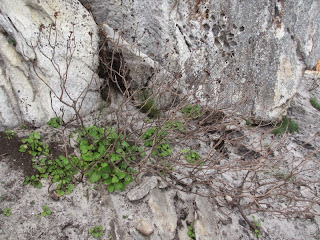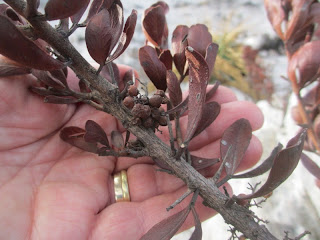The wind was straight from the South Pole and we had a shower at the highest, furthest part of our walk! However, it takes more than that to shake off your hardy Flower Walkers!
I had a feeling we would find no other colour than green on our walk, so I snapped the Prickly Pear Opuntia at the ruins of the Railway Cottages.
The re-growth all over is really impressive especially up close. From a distance the hills still look dark grey. But views like these give us an idea of the Spring we can expect:
We're not sure what they are, but we're pretty sure we remember a pink Watsonia borbonica here:
All the Agapanthus walshii plants we remember are coming back, in most cases, invigorated.
These Fungi we will have to look up or put on iSpot; growing in the cracks of a rotten pine stump.
We think (hope!) this is a Liparia splendens, coming back with a bang!
A Daisy?
Another Daisy?
We thought these would be tightly closed; our 'new find' from last week, Oxalis polyphylla.
This is re-growing in a crack in the rock:
Last week, Dominic told us that if the leaves were growing in threes, it was a strong indication that these are Rhus / Searsia:
... and Pat said that if one folds a leaf and gets a white stripe when folded back flat, it would be a further indication to particular Searsia. But I forgot to fold it! And forgot which one anyway!
But this is definitely something else, maybe the Cape Myrtle Myrsine africana that Dominic suggested:
We're finding plenty of them, and the leaves are pointed and grow opposite one another in pairs.
We're still perplexed by these Wachendorfias with curved leaves growing flat on the ground:
Just 35 paces from the one above, are these which we are pretty sure, are Wachendorfia paniculata:
We know the W. thyrsiflora is the tall one in river beds, and there's W. brachyandra and W. multiflora, and that's it! Maybe the curved flat ones are W. paniculata which got hotter in the fire?
This is going to be interesting!?
Just before the rain came, we saw this strange phenomenon; clouds of vapour coming up from the forest!
The Eikenhof Dam should start filling now that irrigation has stopped.
:-) A

































































